
|
Sale 48
Pre-Long Beach Coin Auction
| Lot |
Photo |
Description |
Realized |
Lot 1726 |
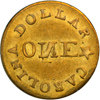 |
Christopher Bechtler, ONE DOLLAR CAROLINA, 28 gr., N reversed. . Kagin-4. PCGS graded AU-50 PQ. Housed in a first generation holder. A pleasing and original example of this popular Territorial gold variety, both sides are colored in naturally toned golden shades with a few tinges of olive accenting the high points, plenty of luster throughout. Abrasions are virtually absent, as might be expect for the Premium Quality highlight we give it, and the devices are well centered with bold striking detail. Pop 14; 51 finer (PCGS # 10055) .
Estimated Value $4,000 - 4,500.
View details and enlarged photos
Check results on similar lots
| Realized
$4,255 |
Lot 1727 |
 |
August Bechtler, 5 DOLLARS CAROLINA, 134 gr. 21 carats. PCGS graded AU-50. Nicely toned. This orange-gold to pale russet example has original color, unlike the many brightened Bechtler pieces. Glimpses of luster outline the protected areas around the legends. No marks are relevant, although there arises a small planchet irregularity above the A in CAROLINA. Struck from rotated dies. Pop 12; 11 finer; 4 in 53; 6 in 55; 1 in 58. (PCGS # 10046) .
Estimated Value $11,000 - 12,000.
View details and enlarged photos
Check results on similar lots
| Unsold |
Lot 1728 |
 |
1849 Moffat & Co. (San Francisco) TEN D. PCGS graded VF-25. Smooth, mark-free surfaces are attractive with yellow gold originality. Evenly worn for the type (these circulated extensively), with some reverse details present in the eagle's wings and legs, and the rims are choice. Pop 28 in all grades of VF; 12 finer. (PCGS # 10249) .
Estimated Value $6,000 - 6,500.
View details and enlarged photos
Check results on similar lots
| Unsold |
Lot 1729 |
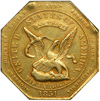 |
1851 U.S. Assay Office $50 "slug", 880 THOUS. Reeded edge. NGC graded AU-55. Some light rose color tone restes within the protected devices. A few minor edge knocks. You have the privilege of bidding on a beautiful historic Territorial gold example with luster that radiates from the around the devices of both obverse and reverse all the way to the peripheries. Not only is it warm golden orange and alluring, but it also is a pretty well struck example. The wings, shield and tail detail on the eagle are nearly completely defined. Pop 9; 31 finer (PCGS # 10211) .
The $50 ingots or "slugs" or "Californians" did pass as money; for most of 1851-53 they were the principal accepted currency in California. Earlier dies gave the issuer's name as AUGUSTUS HUMBERT U.S. ASSAYER OF GOLD; later ones as UNITED STATES ASSAY OFFICE OF GOLD, but it was the same provisional branch mint, located at first on Montgomery St. between Commercial and Clay, later at 608-10 Commercial St. Humbert arrived in San Francisco on Jan. 30, 1851, bringing master dies or hubs, and on January 31 he struck his first octagonal ingots. Quantity issue began Feb. 14. Anticipating Humbert's arrival, Collector of Customs T. Butler King was authorized by President Millard Fillmore, December 2, 1850, to receive any or all issues of the new Assay Office in payment of tariffs: a de facto recognition that they passed as federal money, effective from the first day of issue.
Opposition to the new provisional branch mint arose from the same people who had boycotted the former State Assay Office ingots. Bankers could no longer buy gold dust for $6 to $8 per ounce while Humbert's federal operation paid miners $16 per ounce, less 2.75% manufacturing charges; nor could they sell gold dust to private coiners at high profits.
Worse for the Assay Office's competitors, nearly all private gold coins vanished, most being melted for recoinage into Humbert $50s. This created a coin shortage.
Estimated Value $35,000 - 40,000.
View details and enlarged photos
Check results on similar lots
| Realized
$36,800 |
Lot 1730 |
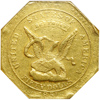 |
1851 U.S. Assay Office $50 "slug", 887 THOUS. Reeded edge. NGC graded AU-53. A nice clean "slug" with some minor bumps on the sharp edges of the octogon. Augustus Humbert, a New York watchcase maker, was appointed United States assayer, and he placed his name and the government stamp on the ingots of gold issued by Moffat & Co. The assay office, a provisional government mint, was a temporary expedient to accommodate the Californians until the establishment of a permanent branch mint.
The fifty-dollar gold piece was accepted as legal tender on a par with standard U.S. gold coins and was known variously as a slug, quintuple eagle, or five-eagle piece. It was officially termed an ingot. Pop 9; 41 finer. (PCGS # 10214) .
Estimated Value $35,000 - 40,000.
View details and enlarged photos
Check results on similar lots
| Realized
$33,350 |
Lot 1731 |
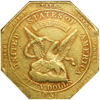 |
1851 U.S. Assay Office $50 "slug", 887 THOUS. Reeded edge. NGC graded AU-55. A most attractive "slug" with natural rose color toning resting within the center legends. Slightly less well struck at the outer margin but most of the legend still readable, including a full date.
A compromise of sorts too place with a coinage act of Sept. 30, 1850, establishing not a branch mint, which the California business community had requested from the U.S. government, but a federal Assay Office of Gold in San Francisco, authorizing issue of ingots of $50 to $10,000 value, "to be struck of refined gold, of uniform fineness, and with appropriate legends and devices, similar to those on our smaller coins with their value conspicuously marked, and the inscriptions LIBERTY and UNITED STATES OF AMERICA." This weasel wording concealed what the California authorities and Mint Director R. M. Patterson well knew: The ingots would circulate as money, with inscriptions conforming to the Mint Act of April 2, 1792, differing primarily in denomination from normal federal coins.
As a stopgap, the $50 slugs served their purpose. Hundreds of thousands of them were produced, but subsequently a huge percentage of the issue was turned in to the federal Mints and melted. Pop 13; 28 finer (PCGS # 10214) .
Native California ores ranged from about 850/1000 to 925/1000 gold, according to the Breen encyclopedia, the rest 75-150/1000 silver. Federal gold coins had to contain 900/100 gold, not over 50/1000 silver, the rest copper, pursuant to the Act of Jan. 18, 1837. To bring California gold to the federal standard required copper (very scarce) and parting acids (concentrated nitric, sulfuric, and hydrochloric acids), which were not locally made, and could not be safely shipped either overland or via Panama or Cape Horn.
The new Mint Director, George N. Eckert, wrote to Treasury Secretary Corwin that some 150,000 lbs. of parting acids would be necessary for each year's operations in San Francisco. In practice, substandard gold was brought to stated fineness (880, 884, 887, or 900) by adding measured weights of proofing pieces (small bars of 999 + Fine gold) to each melt, and deducting their cost from the value of the finished coins; but parting acids were necessary to make proofing pieces. Calling the new coins "ingots" and the new provisional branch mint "U.S. Assay Office of Gold" was a neat solution, evading any possible legal penalties. But the Philadelphia Mint officials treated Augustus Humbert as a branch-mint superintendent, requiring him to report monthly gold and unparted ingot manufactures on the same kinds of forms used by all branch mints; they supervised manufacture of master dies and hubs for the ingots.
Estimated Value $35,000 - 40,000.
View details and enlarged photos
Check results on similar lots
| Realized
$36,800 |
Lot 1732 |
 |
1851 U.S. Assay Office $50 "slug", 887 THOUS. Reeded edge. PCGS graded Fine-15. Normal amount of light marks for this grade. An historic offering, the $50 gold pieces of the Gold Rush period served as the chief means of monetary transactions for several years, and saw hard service. Hundreds of thousands were produced, but you wouldn't know that from the surviving numbers. For once the U.S. Mint opened in San Francisco in 1854, large numbers of the Territorial Gold pieces, not only $50 slugs but all others, were gathered up and recoined into (mostly) $10 Eagles and $20 Double Eagles. Pop 14 in Fine condition (PCGS # 10214) .
Estimated Value $11,000 - 12,000.
View details and enlarged photos
Check results on similar lots
| Realized
$11,500 |
Lot 1733 |
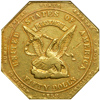 |
1852 U.S. Assay Office $50 "slug", 887 THOUS. Reeded edge. NGC graded AU-55. Some light tone rests within the legends. Wonderful still-lustrous surfaces are flourishing with rich reddish gold color and brilliance, all natural and immersed in the history of the California gold rush. Well struck for the date, with all obverse details present, including the outer legend which reads AUGUSTUS HUMBERT UNITED STATES ASSAYER OF GOLD CALIFORNIA 1852. Rarely does anything approaching "full" occur on these often unevenly struck pieces. Fully struck coins like this are desirable. Also, most examples of these large "slugs" are considerably worn and exhibit substantial damage. The present offering is a happy exception.
The $50 octagonal "slug," sometimes called an adobe in local trade, was the mainstay of California business in the first chaotic years of the gold rush (1849-55). Such pieces were for large transactions only, being the medium of choice, since paper money was illegal in California under the Constitution of 1850. At the time, lesser denomination gold coins were not plentiful.
Octagonal $50 pieces were last minted in 1852, but in use for much of the decade until the San Francisco mint coinage became abundant. Many slugs went to the Philadelphia Mint, where they were melted into bullion, then recast into federal denominations. Pop 5; 14 finer (PCGS # 10217) .
Estimated Value $35,000 - 40,000.
View details and enlarged photos
Check results on similar lots
| Realized
$36,800 |
Lot 1734 |
 |
1853 U.S. Assay Office $20 Gold, 900 THOUS. PCGS graded MS-63. A splendidly preserved coin, this is one of the finest examples known Assay Office Territorial $20 gold pieces. Unlike many Assay pieces, the fields of this coin do not display the rough metal flow often found. Instead, the golden luster on this untoned example is gleaming, satiny and shows excellent color. The surfaces are vibrant. Lightly abraded on each side with no obvious or singly distracting blemishes other than a shallow graze in the frost below the scroll, while the striking details are uncommonly well defined. In fact, the strike displays a sharp shield and separated arrow feather details in the center of the obverse, the often-problematic highest point on that side. Rich brilliant-gold color covers the surfaces of this important coin. Pop 29; 22 finer; 17 in 64; 5 in 65. (PCGS # 10013) .
Estimated Value $22,000 - 24,000.
View details and enlarged photos
Check results on similar lots
| Unsold |
Lot 1735 |
 |
1853 U.S. Assay Office $20 Gold, 900 THOUS. PCGS graded MS-61. The lustrous surfaces are nice and frosty. We note some light reverse rim nicks. In an old green label holder. Gold-gold satin frost is boldly hypnotic on this fresh-appearing Assay Office $20 gold Territorial. Since our observation is that this date is nearly always fully struck, then this sharp coin has every suggestion of precision manufacture as seen in eagle's body, wing and neck feathers, the shield and arrows, and all lettering and legends on both sides. An historic offering. Many Assay Office coins were later melted following the opening of the U.S. Mint in San Francisco. Pop 18; 83 finer (PCGS # 10013) .
Note: the notation of .900 Fine on this coin refers to the Mint standard of 90% gold with 10% alloy (for hardening to improve wearability). At the time, many Territorial minters were having difficulty refining their gold to the exacting standards of Federal coinage. The Assay Office, being an unofficial but still government sanctioned mint, the importance of minting .900 Fine coins was key to their acceptability.
Estimated Value $10,000 - 11,000.
View details and enlarged photos
Check results on similar lots
| Unsold |
Lot 1736 |
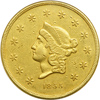 |
1855 Wass, Molitor & Co. (San Francisco) $50 Gold. NGC graded AU-58. Housed in NGC holder 5026290-004. An excellent example for the grade and free from the heavy digs and rim bruses that usually accompany this massive round coin. This historic and nicely preserved AU58 $50 gold piece has rare beauty that comes with fully defined design features plus a strict limitation on surface marks. What's more, the rims are choicer than average for what is often a bunged-about Type, wherein use in circulation tended to damage the soft rim areas. While the octagonal fifties from the Assay Office get much of the news reportage in the American numismatic press, that is only because they are seen ten times more often than a Wass $50 piece.
The firm of Wass, Molitor & Company was comprised of Samuel Wass and Agoston Molitor, who operated their well-respected private mint in the Bay area from 1852. Their first deliveries consisted of five- and ten-dollar gold pieces for local use. They ceased minting when the San Francisco Mint opened in 1854, but resumed with production of the famous $50 denomination round gold coins in 1855. This was at a time when the federal facility was obliged to close from time to time for lack of proper parting acids to refine gold dust with the requisite copper alloy. The fifty dollar Wass, Molitor pieces filled the void at this critical time. Reports are the Wass Molitor coinage had one of the highest intrinsic values of any of the private issues in California. Many were subsequently melted. Pop 2; 8 finer (PCGS # 10363) .
According to Dr. Donald Kagin, "Wass, Molitor & Co. closed down their operation soon after the 1855 issues were distributed, for the 1856-1857 San Francisco Directory lists the assaying firm of Wass (Karoly) Usznay & Co. as operating during 1856 and 1857. Haraszthy replaced Molitor as partner in this firm, as the latter had left California for London in 1856." Dr. Kagin's book "Private Gold Coins and Patterns of the United States," gives an detailed account of the Territorial issues, including a full description of the Wass, Molitor company and its gold coins.
Estimated Value $80,000 - 90,000.
View details and enlarged photos
Check results on similar lots
| Unsold |
Lot 1737 |
 |
1855 Wass, Molitor & Co. (San Francisco) $50 Gold. PCGS graded EF-45. A very pleasing example for the grade and all lightly toned. A bold example of this history $50 denomination with strong underlying presence due to the originality and freedom from problems. Nicely struck, indeed completely so, with the surfaces close enough to choice to where special mention is merited. Indeed, the surface originality on this coin easily rivals that of the few others that reach the auction scene from time to time.
It was 1852 before Wass and Molitor, trained in metallurgy in Germany and their native Hungary, began striking gold coins. Many of the lesser California gold issuers -- the Dubosq, Schultz, Dunbar, and Baldwin -- had been forced out of business when their underweight coins were exposed in 1851. Wass, Molitor's production consisted of the expected coins: five dollar and ten dollar pieces and later twenty dollar and fifty dollar pieces, all of which were urgently required for commerce in the days before a functioning Federal mint. The coins were of full weight and fineness, they were, with the Moffat and Humbert-Assay Office pieces, among the most widely accepted in the western part of the country. Pop 8; 11 finer (PCGS # 10363) .
Estimated Value $45,000 - 50,000.
View details and enlarged photos
Check results on similar lots
| Realized
$48,875 |
Lot 1738 |
 |
1849 Mormon $5 Gold. PCGS graded AU-50. Light golden toning and quite choice for the grade. A carefully made coin with strong fundamental devices and original luster in the fields and devices. Nicely struck Mormon gold is a rarity since most, though not all, are poorly struck. This piece is close enough to razor-sharp that special mention is merited. Notice in the photographs how the two clasping hands show complete separation of the one hand's thumb, with plainly visible thumbnail! Indeed, the strike of the present coin easily rivals that of some "big name" specimens that have sold in the last fifty years. In an old green label holder. Pop 8; 20 finer (PCGS # 10262) .
The Mormons established the Deseret Mint. December 10, 1848, according to Mormon and Utah Coin and Currency. A man by the name of William I. Follett deposited the first supply of gold, for which he received $232 for 14.5 ounces of gold at $16 per ounce. The gold was then melted, rolled into sheets, and put through punching and coining presses that stamped the finalized designs onto the coins. The first coins struck at the Deseret Mint were of the $10 denomination, of which five were paid to Follett two days later. But the highest production was in the $5 denomination with the pieces dated 1849, 1850, and 1860 (beehive type) being particularly desirable.
Estimated Value $30,000 - 35,000.
View details and enlarged photos
Check results on similar lots
| Unsold |
Lot 1739 |
 |
1860 Clark, Gruber & Co. (Denver, Colorado) $5 Gold. PCGS graded MS-63. In PCGS holder 22073377. A nice bold strike in natural greenish color gold with rich golden overtones. A most attractive example and quite choice for the grade. Devices are sharp in all areas, as struck, which Territorial collectors will spot at once as above-average and which the grading service has taken into consideration in assigning the grade, as also desired by collectors. Clark, Gruber and Company was a prolific issuer of private gold coins during the opening of the West.
The placer gold deposits along the rivers and streams of the region supplied much of the material that went into Gruber's coinage, though the placer deposits rapidly played out. But miners soon discovered far more valuable seams of hard rock gold, silver, and other minerals in the nearby mountains.
The Provisional Government of the Territory of Jefferson (now known as Colorado) was organized on October 24, 1859, but the new territory failed to secure federal sanction. The election of Abraham Lincoln for U.S. President in November 1860, led to the secession of six slave states and the threat of civil war. Seeking to augment the political power of the free states, the Republican-led U.S. Congress hurriedly admitted the eastern portion of the Territory of Kansas to the Union as the free State of Kansas on in January 1861, leaving the western portion of the territory, and its gold fields, unorganized.
Thirty days later on in February 1861, outgoing U.S. President James Buchanan signed an act of Congress organizing the free Territory of Colorado. Pop 4; 4 finer with 2 in 64, 2 in 65 (PCGS # 10136) .
Estimated Value $22,000 - 24,000.
View details and enlarged photos
Check results on similar lots
| Unsold |
Lot 1740 |
 |
1860 Clark, Gruber & Co. (Denver, Colorado) $10 Gold. PCGS graded AU-53. A beautiful example of the popular Pikes Peak $10.00. Delicately toned. A solid AU53 in all regards. The still lustrous surfaces are alight with yellow-gold frosty luster, the strike is clear-cut including the eagle as well as the trees at the base of the mountain. The eye appeal is nothing short of exceptional with the only marks of note being in the field below LD on the obverse and below the left wing of the eagle. In an old green label holder. Pop 9; 42 finer (PCGS # 101) .
The predecessors of the Denver Mint were the men of Clark, Gruber & Company. During the Pikes Peak Gold Rush, they coined gold dust brought from the gold fields by the miners. For almost three years, they minted gold coins (1860-61) and ingots (1862). They were formally bought by the US Treasury in 1863.
Estimated Value $20,000 - 25,000.
View details and enlarged photos
Check results on similar lots
| Unsold |
|
|